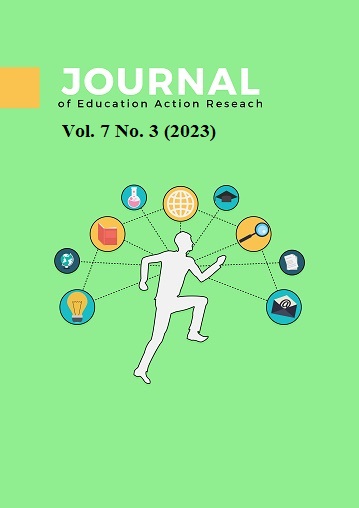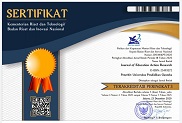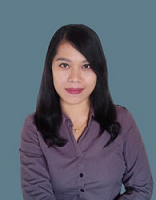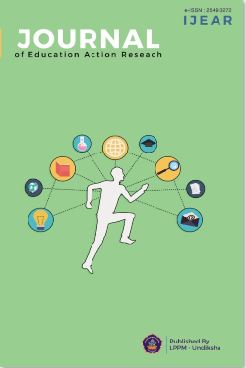Peningkatan Kemampuan Berpikir Spasial: Implementasi Model Problem Based Learning melalui Pendekatan Self Efficacy Berbantuan WebGIS Inarisk
DOI:
https://doi.org/10.23887/jear.v7i3.63881Keywords:
Berpikir Spasial, Problem Based Learning, Self Efficacy, WebGIS InariskAbstract
Kemampuan berpikir spasial merupakan aspek yang dibutuhkan berkaitan dengan konsep spasial yang menjadikan pembelajaran sangat bermakna dalam memahamai fenomena geosfer. Rendahnya nilai kemampuan berpikir spasial peserta didik dengan dalam pembelajaran geografi, menjadikan pembelajaran kurang bermakna. Penelitian ini bertujuan untuk menganalisis implementasi model pembelajaran problem based learning (PBL) dengan pendekatan self efficacy berbantuan webGIS inarisk untuk meningkatkan kemampuan berpikir spasial peserta didik pada materi persebaran dan mitigasi bencana alam. Penelitian ini merupakan penelitian tindakan kelas (PTK) partisipan dengan menggunakan model Kemmis & Taggart. Subjek penelitian 38 peserta didik. Penentuan subjek dan lokasi penelitian berdasarkan hasil observasi selama Asistensi Mengajar. Pengumpulan data menggunakan 5 soal tes kemampuan berpikir spasial yang mengacu pada indikator Joe & Bernard. Pengolahan data diperoleh dari hasil tes kemampuan berpikir spasial sebanyak 2 siklus dengan mengetahui peningkatan pada setiap tahapannya. Hasil penelitian menunjukkan terdapat peningkatan kemampuan berpikir spasial yang signifikan pada setiap tahapannya. Implementasi model PBL melalui pendekatan self efficacy berbantuan webgis inarisk mampu memberikan kolaborasi dan keyakinan peserta didik untuk menemukan solusi dari permasalahan geosfer dalam aspek keruangan.
References
Alfianiawati, T., Desyandri, & Nasrul. (2019). Pengaruh Penggunaan Model Problem Based Learning terhadap Hasil Belajar Siswa dalam Pembelajaran ISD di Kelas V SD. Ejournal Pembelajaran Inovasi: Jurnal Ilmiah Pendidikan Dasar, 7(3), 1–10. DOI: https://doi.org/10.24036/jippsd.v3i1.106194
Aliman, M. (2020). Pengembangan Instrumen Tes Kemampuan Berpikir Spasial Bagi Siswa SMA. Geodika: Jurnal Kajian Ilmu Dan Pendidikan Geografi, 4(1), 1–10. https://doi.org/10.29408/geodika.v4i1.1823. DOI: https://doi.org/10.29408/geodika.v4i1.1823
Amin, S., Sumarmi, Bachri, S., Susilo, S., & Bashith, A. (2020). The Effect of Problem-Based Hybrid Learning (PBHL) Models on Spatial Thinking Ability and Geography Learning Outcomes. International Journal of Emerging Technologies in Learning, 15(19). https://doi.org/10.3991/ijet.v15i19.15729. DOI: https://doi.org/10.3991/ijet.v15i19.15729
Arikunto, S., Suhardjono, & Supardi. (2015). Penelitian Tindakan Kelas. PT. Bumi Aksara.
Arisanti, D. A. K., Dantes, N., & Suastika, I. N. (2022). Environmental Oriented Problem-Based Learning (PBL) Improves Learning Outcomes and Self-Efficacy of Students In Social Studies In Fifth-Grade Elementary Schools. Journal for Lesson and Learning Studies, 5(3), 377–384. https://doi.org/10.23887/jlls.v5i3.48537. DOI: https://doi.org/10.23887/jlls.v5i3.48537
Asiyah, S., Putri, M. K., Heldayani, E., Oktavia, M., Chairunisa, E. D., & Aryaningrum, K. (2020). Pemanfaatan Seni Kartografi Untuk Meningkatkan Kemampuan Spasial Siswa Sma Negeri 1 Pemulutan. Jurnal Pengabdian Kepada Masyarakat, 26(1), 12. https://doi.org/10.24114/jpkm.v26i1.14838. DOI: https://doi.org/10.24114/jpkm.v26i1.14838
Astawa, I. B. M. (2022). Peningkatan Spatial Thinking Skills Siswa dalam Pembelajaran Geografi melalui Metode Demonstrasi Berpendekatan Kontekstual. Journal of Education Action Research, 6(2), 242–251. https://doi.org/10.23887/jear.v6i2.45526. DOI: https://doi.org/10.23887/jear.v6i2.45526
Astawa, I. B. M., Citrawathi, D. M., Sudiana, I. K., & Wulandari, I. G. A. A. M. (2022). The Effect Of Flipped Classroom Based On Disaster Map Visualization In Disaster Mitigation Learning On Students’ Self-Efficacy And Critical Thinking Skills. Jurnal Pendidikan IPA Indonesia, 11(2). https://doi.org/10.15294/jpii.v11i2.35308. DOI: https://doi.org/10.15294/jpii.v11i2.35308
Aulia, H., Kantun, S., & Kurnianto, F. A. (2023). Analisis Integrasi Keterampilan Abad 21 dan Keterampilan Berpikir Spasial pada Buku Teks Geografi. Jurnal Pendidikan Geografi, 10(1), 129–141. https://doi.org/10.20527/jpg.v10i1.14528. DOI: https://doi.org/10.20527/jpg.v10i1.14528
Cao, K., Qi, Y., Neo, H. Y. R., & Guo, H. (2023). Web GIS as a pedagogical tool in tourist geography course: the effect on spatial thinking ability and self-efficacy. Journal of Geography in Higher Education, 00(00), 1–18. https://doi.org/10.1080/03098265.2023.2198200. DOI: https://doi.org/10.1080/03098265.2023.2198200
Destiana, B. J. P., Sarwono, S., & Wijayanti, P. (2023). The Effect of Problem-Based Flipped Classroom Learning Accompanied by Digital Literacy Using Edpuzzle on Spatial Problem-Solving Abilities for 7th-Grade Students at Pangudi Luhur Ambarawa Junior High School. International Journal of Social Science And Human Research, 06(04), 2344–2353. https://doi.org/10.47191/ijsshr/v6-i4-44. DOI: https://doi.org/10.47191/ijsshr/v6-i4-44
Duarte, L., Teodoro, A. C., & Gonçalves, H. (2022). Evaluation of Spatial Thinking Ability Based on Exposure to Geographical Information Systems (GIS) Concepts in the Context of Higher Education. ISPRS International Journal of Geo-Information, 11(8). https://doi.org/10.3390/ijgi11080417. DOI: https://doi.org/10.3390/ijgi11080417
Effendi, R., Herpratiwi, H., & Sutiarso, S. (2021). Pengembangan LKPD Matematika Berbasis Problem Based Learning di Sekolah Dasar. Jurnal Basicedu, 5(2), 920–929. https://doi.org/10.31004/basicedu.v5i2.846. DOI: https://doi.org/10.31004/basicedu.v5i2.846
Emiliyati. (2023). Penerapan Pembelajaran Diferensiasi Pada Materi Konsep Geografi Melalui Problem Based Learning (PBL). Journal of Media, Sciences and Education, 2(1), 88–100.
Fargher, M. (2018). WebGIS for geography education: Towards a GeoCapabilities approach. ISPRS International Journal of Geo-Information, 7(3). https://doi.org/10.3390/ijgi7030111. DOI: https://doi.org/10.3390/ijgi7030111
Fatmawati, D., Yushardi, Y., Nurdin, E. A., Astutik, S., & Kurnianto, F. A. (2023). Pengaruh Model Pembelajaran Resource Based Learning (RBL) Berbasis Augmented Reality (AR) terhadap Kemampuan Berpikir Spasial Siswa SMA. Majalah Pembelajaran Geografi, 6(1), 72. https://doi.org/10.19184/pgeo.v6i1.38555. DOI: https://doi.org/10.19184/pgeo.v6i1.38555
Febrianto, A. D., Purwanto, P., & Irawan, L. Y. (2021). Pengaruh penggunaan media Webgis Inarisk terhadap kemampuan berpikir spasial siswa pada materi mitigasi dan adaptasi bencana. Jurnal Pendidikan Geografi, 26(2), 73–84. https://doi.org/10.17977/um017v26i22021p073. DOI: https://doi.org/10.17977/um017v26i22021p073
Golightly, A., & Muniz, O. A. (2013). Are South African Geography education students ready for problem-based learning? Journal of Geography in Higher Education, 37(3), 432–455. https://doi.org/10.1080/03098265.2013.794332. DOI: https://doi.org/10.1080/03098265.2013.794332
Haris, F., Mardin, R., & Mahfudz, A. (2021). Identifikasi Kemampuan Berfikir Spasial Peserta Didik Menggunakan Citra Penginderaan Jauh Dan Peta Pada Mata Pelajaran Geografi Di Kelas X SMA Negeri 5 Model Palu. Jurnal Pendidikan Dan Ilmu Sosial, 9(1), 25–38. DOI: https://doi.org/10.31851/swarnabhumi.v5i1.3221
Harmelia, D., & Djuwita, P. (2022). Pengaruh Model Problem Based Learning (PBL) terhadap Kemampuan Membangun Sikap Mandiri dan Hasil Belajar Siswa Pada Mata Pelajaran PKn Kelas IV SD Negeri 75 Kota Bengkulu. Jurnal Pembelajaran Dan Pengajaran Pendidikan Dasar, 5(2). https://doi.org/10.33369/jp3d.v5i2.14749.
Hasbie, M., Aufa, M. N., Fitri, M. A., Saputra, M. A., & Hasbie, M. (2023). Development of Science Module on the Topic of Interaction of Living Things and the Environment Using the Scientific Critical Thinking ( SCT ) Model to Improve Critical Thinking Ability and, 9(3), 1348–1351. https://doi.org/10.29303/jppipa.v9i3.2458. DOI: https://doi.org/10.29303/jppipa.v9i3.2458
Hidayanti, I. H., Sumarmi, S., & Utomo, D. H. (2019). Pengaruh Model Relating, Experiencing, Applying, Cooperating, Transferring terhadap Kemampuan Berpikir Spasial Siswa SMA. Jurnal Pendidikan: Teori, Penelitian, Dan Pengembangan, 4(9), 1222. https://doi.org/10.17977/jptpp.v4i9.12730. DOI: https://doi.org/10.17977/jptpp.v4i9.12730
Huh, S., & Jo, I. (2023). Successes and Struggles: Evaluating Geospatial Technologies Integration in Geography Lessons using TPACK. Journal of Geography, 0(0), 1–14. https://doi.org/10.1080/00221341.2023.2224814. DOI: https://doi.org/10.1080/00221341.2023.2224814
Hutagalung, S. S., & Indrajat, H. (2023). Multistakeholder Education Model in Strengthening Literacy and Disaster Awareness in Lampung Province. KnE Social Sciences, 2023, 306–315. https://doi.org/10.18502/kss.v8i5.13006. DOI: https://doi.org/10.18502/kss.v8i5.13006
Jayanti, M. A., & Jamil, A. M. M. (2020). Pemanfaatan Sistem Informasi Geografis Kolaboratif Pada Kawasan Rawan Bencana Banjir Di Wilayah Peri Urban Kota Malang. JPIG (Jurnal Pendidikan Dan Ilmu Geografi), 5(1). https://doi.org/10.21067/jpig.v5i1.3852. DOI: https://doi.org/10.21067/jpig.v5i1.3852
Jazuli, M., Rusijono, R., & Bachri, B. S. (2022). Pengaruh Model Pembelajaran Earthcomm Terhadap Kemampuan Berpikir Spasial Di Mas Al-Mas’Udy Mojokerto. Jurnal Ilmiah Mandala Education, 8(4), 2907–2914. https://doi.org/10.58258/jime.v8i4.4055. DOI: https://doi.org/10.58258/jime.v8i4.4055
Jo, I., & Bednarz, S. W. (2011). Textbook questions to support spatial thinking: Differences in spatiality by question location. Journal of Geography, 110(2), 70–80. https://doi.org/10.1080/00221341.2011.521848. DOI: https://doi.org/10.1080/00221341.2011.521848
Karaoglan-Yilmaz, F. G., Ustun, A. B., Zhang, K., & Yilmaz, R. (2023). Metacognitive Awareness, Reflective Thinking, Problem Solving, and Community of Inquiry As Predictors of Academic Self-Efficacy in Blended Learning: a Correlational Study. Turkish Online Journal of Distance Education, 24(1), 20–36. https://doi.org/10.17718/tojde.989874. DOI: https://doi.org/10.17718/tojde.989874
Kemmis, S. (2012). Researching educational praxis: Spectator and participant perspectives. British Educational Research Journal, 38(6), 885–905. DOI: https://doi.org/10.1080/01411926.2011.588316
Khusna, N. I., Sumarmi, Bachri, S., Astina, I. K., Nurhayati, D. A. W., & Shresthai, R. P. (2022). New Technologies for Project-Based Empathy Learning in Merdeka Belajar (Freedom to Learn): The Use of inaRISK Application and Biopore Technology. International Journal of Interactive Mobile Technologies, 16(22). https://doi.org/10.3991/ijim.v16i22.36153. DOI: https://doi.org/10.3991/ijim.v16i22.36153
Liu, M., Cai, Y., Han, S., & Shao, P. (2023). Understanding Middle School Students’ Self-Efficacy and Performance in a Technology-Enriched Problem-Based Learning Program: A Learning Analytics Approach. Journal of Educational Technology Systems, 51(4), 513–543. https://doi.org/10.1177/00472395231174034. DOI: https://doi.org/10.1177/00472395231174034
Londa, T. K., & Kamaruddin, K. (2023). Jurnal Pendidikan Fisika The Implementation of Project Based Learning ( PjBL ) to Enhanced Understanding of Environmental Conservation and. Jurnal Pendidikan Fisika, 11(2), 153–160. https://doi.org/10.26618/jpf.v11i2.10574. DOI: https://doi.org/10.26618/jpf.v11i2.10574
Manek, A. H., Utomo, D. H., & Handoyo, B. (2019). Pengaruh Model Spasial Based Learning terhadap Kemampuan Berpikir Kritis Siswa. Jurnal Pendidikan: Teori, Penelitian, Dan Pengembangan, 4(4), 440. https://doi.org/10.17977/jptpp.v4i4.12245. DOI: https://doi.org/10.17977/jptpp.v4i4.12245
Najifatuz Zuhria, N., . P., Masitoh, F., Soelistijo, D., & Pertiwi, E. (2023). Development of ICARE-based Geography E-Module Integrated with STEM Using a Spatial Approach to Improve Students’ Spatial Thinking Ability. KnE Social Sciences, 2022(2022), 145–165. https://doi.org/10.18502/kss.v8i8.13293. DOI: https://doi.org/10.18502/kss.v8i8.13293
Niman, E. M., & Wejang, H. E. A. (2023). Students’ spatial thinking toward the school environment in Indonesia. Interdisciplinary Journal of Education Research, 5, 61–71. https://doi.org/10.38140/ijer-2023.vol5.06. DOI: https://doi.org/10.38140/ijer-2023.vol5.06
Nisa, K., Soekamto, H., Wagistina, S., & Suharto, Y. (2021). Model Pembelajaran EarthComm pada Mata Pelajaran Geografi: Pengaruhnya terhadap Kemampuan Berpikir Spasial Siswa SMA. Jurnal Ilmiah Pendidikan Profesi Guru, 4(3), 500–510. https://doi.org/10.23887/jippg.v4i3.40031. DOI: https://doi.org/10.23887/jippg.v4i3.40031
Nurcahyo, A. D., & Winanti, E. T. (2021). Pengaruh model Problem Based Learning terintegrasi pendekatan induktif terhadap kemampuan berpikir spasial dan pengetahuan siswa pada materi mitigasi bencana. Jurnal Pendidikan Geografi, 26(1), 41–47. https://doi.org/10.17977/um017v26i12021p041. DOI: https://doi.org/10.17977/um017v26i12021p041
Purwanto, P., Hidayah, N., & Wagistina, S. (2023). The Effect of Gersmehl ’ s Spatial Learning on Students ’ Disaster Spatial Literacy. International Journal of Educational Methodology, 9(2), 345–354. DOI: https://doi.org/10.12973/ijem.9.2.345
Putra, A. K., Sumarmi, Deffinika, I., & Islam, M. N. (2021). The effect of blended project-based learning with stem approach to spatial thinking ability and geographic skill. International Journal of Instruction, 14(3). https://doi.org/10.29333/iji.2021.14340a. DOI: https://doi.org/10.29333/iji.2021.14340a
Riyansyah, R., & Masturi, M. (2023). Education of Tidal Flood Disaster Mitigation and Environmental Awareness Through Simulation Video Assisted-Problem Based Learning Model. Jurnal Penelitian Pendidikan IPA, 9(4), 1720–1726. https://doi.org/10.29303/jppipa.v9i4.3363. DOI: https://doi.org/10.29303/jppipa.v9i4.3363
Sagun, R. D., & Prudente, M. (2023). Applying the plan-do-study-act (PDSA) action research model to re-structure the science classroom conforming to the metacognitive orientation standards. Educational Action Research, 31(1), 61–77. https://doi.org/10.1080/09650792.2021.1894964. DOI: https://doi.org/10.1080/09650792.2021.1894964
Santoso, A. (2022). Pengaruh Media Pembelajaran Google Earth Terhadap Kemampuan Berpikir Spasial Siswa SMA. Geodika: Jurnal Kajian Ilmu Dan Pendidikan Geografi, 6(2), 152–162. https://doi.org/10.29408/geodika.v6i2.5998. DOI: https://doi.org/10.29408/geodika.v6i2.5998
Siahaan, M., Oktaviani, K., & Julia, J. (2021). Immersive Learning Experience pada Pembelajaran Daring dengan Penggunaan Virtual Reality. Jurnal Teknik Informatika UNIKA Santo Thomas, 06, 13–20. https://doi.org/10.54367/jtiust.v6i1.1052. DOI: https://doi.org/10.54367/jtiust.v6i1.1052
Silviariza, W. Y., Sumarmi, Utaya, S., & Bachri, S. (2023). Development of evaluation instruments to measure the quality of spatial problem based learning (SPBL): CIPP framework. International Journal of Instruction, 16(2), 413–436. DOI: https://doi.org/10.29333/iji.2023.16223a
Somantri, L., & Hamidah, S. (2023). Effects of webGIS-based spatial intelligence training on Geography teacher’s spatial skills. Jurnal Pendidikan Geografi: Kajian, Teori, Dan Praktik Dalam Bidang Pendidikan Dan Ilmu Geografi, 28(1), 75–83. https://doi.org/10.17977/um017v28i12023p75-83.
Sumarmi, Bachri, S., Irawan, L. Y., Putra, D. B. P., Risnani, & Aliman, M. (2020). The effect of experiential learning models on high school students learning scores and disaster countermeasures education abilities. Journal for the Education of Gifted Young Scientists, 8(1), 61–85. https://doi.org/10.17478/jegys.635632. DOI: https://doi.org/10.17478/jegys.635632
White, H., & Forbes, C. T. (2023). An investigation of undergraduate students’ spatial thinking about groundwater. Journal of Geography in Higher Education, 47(1), 128–148. https://doi.org/10.1080/03098265.2021.2004582. DOI: https://doi.org/10.1080/03098265.2021.2004582
Wijayanto, B., Sumarmi, S., Hari Utomo, D., Handoyo, B., & Aliman, M. (2023). Problem-based learning using e-module: Does it effect on student’s high order thinking and learning interest in studying geography? Journal of Technology and Science Education, 13(3), 613. https://doi.org/10.3926/jotse.1965. DOI: https://doi.org/10.3926/jotse.1965
Windiyani, T., Sofyan, D., Iasha, V., Elfrida, Y., & Siregar, Y. (2023). Utilization of Problem-based Learning and Discovery Learning : The Effect of Elementary School Students ’ Capacity for Problem-Solving Based on Self-Efficacy. Al-Islah: Jurnal Pendidikan, 15(2), 1458–1470. https://doi.org/10.35445/alishlah.v15i2.2481. DOI: https://doi.org/10.35445/alishlah.v15i2.2481
Yolantia, C., Artika, W., Nurmaliah, C., Rahmatan, H., & Muhibbuddin, M. (2021). Penerapan Modul Problem Based Learning terhadap Self Efficacy dan Hasil Belajar Peserta Didik. Jurnal Pendidikan Sains Indonesia, 9(4), 631–641. https://doi.org/10.24815/jpsi.v9i4.21250. DOI: https://doi.org/10.24815/jpsi.v9i4.21250
Zhao, R., Liu, X., & Xu, W. (2020). Integration of coseismic deformation into WebGIS for near real-time disaster evaluation and emergency response. Environmental Earth Sciences, 79(18), 1–11. https://doi.org/10.1007/s12665-020-09153-6. DOI: https://doi.org/10.1007/s12665-020-09153-6
Downloads
Published
How to Cite
Issue
Section
License
Copyright (c) 2023 Randy Tirto Buana, Alfyananda Kurnia Putra

This work is licensed under a Creative Commons Attribution-ShareAlike 4.0 International License.












